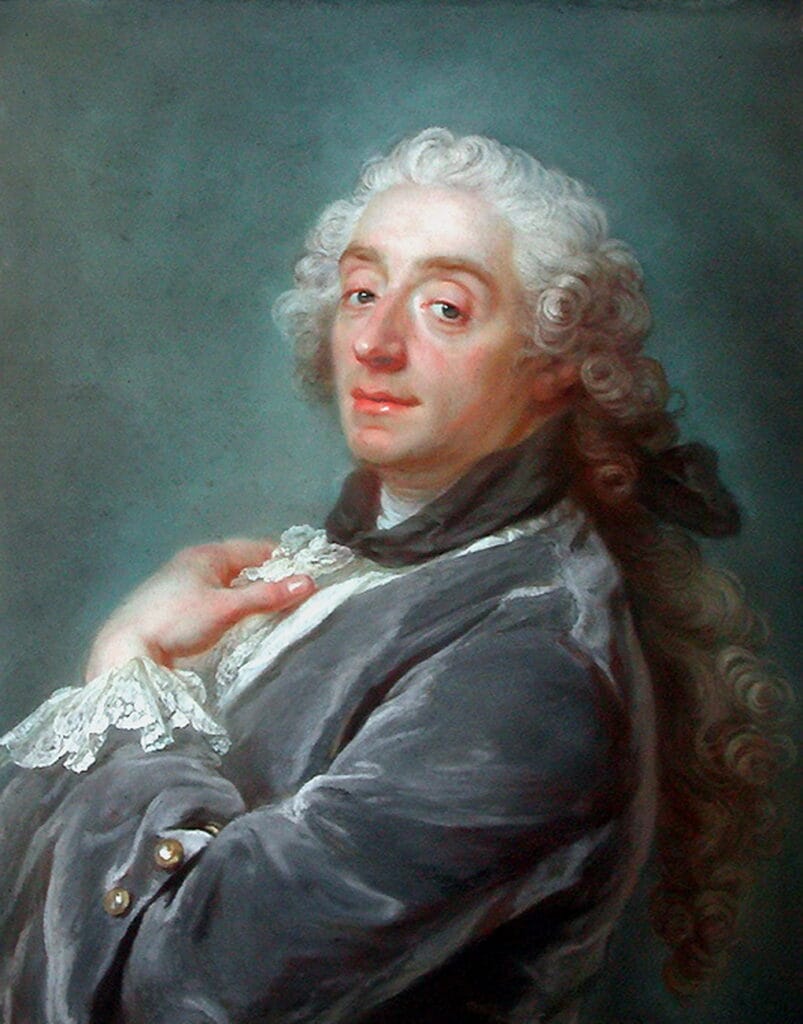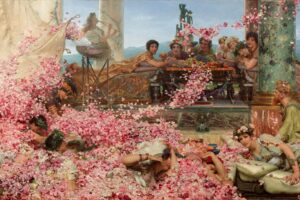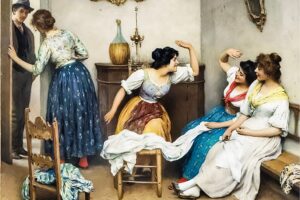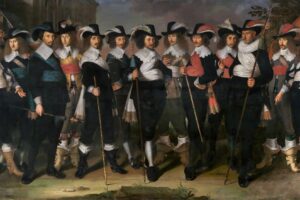By François Boucher, 1768
Imagine a warm afternoon beneath the shade of leafy trees, where a soft breeze carries the scent of blossoms and the air is filled with laughter. That’s the charming world François Boucher welcomes us into with Les Sabots—which means The Clogs in French. Painted in 1768, this delightful scene is a perfect example of Boucher’s talent for turning simple country life into something graceful, romantic, and full of charm.
A Moment of Flirtation and Delight
At the center of the painting, a young couple shares a tender, playful moment in the countryside.
- The Young Woman, seated just above her companion, looks down with a gentle, knowing smile. Her dress is light and flowing, her shoulders bare in the relaxed fashion of a shepherdess. A pink ribbon ties back her hair, and a rose peeks from her bodice. With two fingers, she holds a single cherry—offering it not just as fruit, but as a sweet token of affection.
- The Young Man lounges at her feet, leaning comfortably against a stone. Dressed in a loose shirt, red vest, and blue trousers, he gazes up eagerly, mouth slightly open to receive the cherry she teases. A woven basket of cherries rests in his lap, suggesting the two have just spent time gathering them together.
Their expressions are full of warmth, connection, and innocent play—just one cherry, but a whole story of affection.
Details That Bring the Scene to Life
Boucher fills this countryside setting with quiet symbols of love, leisure, and rustic simplicity.
- The Wooden Clogs, placed near the young man’s bare feet, give the painting its name. These humble shoes speak to a rural, grounded life—adding contrast to the elegance of the figures and reminding us that love can be both simple and profound.
- A Basket Overflowing with bright red cherries adds rich color and abundance. The cherries reflect the season—spring or early summer—and serve as a symbol of sweetness, desire, and the pleasures of nature.
- Surrounding Nature is soft and full of life. Delicate roses bloom near the couple, and the tall tree above shelters them in a canopy of green. In the distance, the blue sky fades into dreamy clouds and rolling hills, hinting at a peaceful world beyond their quiet moment.
- Boucher’s Signature, discreetly placed near the clogs, reminds us that this tender scene was crafted by one of the Rococo era’s greatest artists—known for painting love not as a grand drama, but as a shared smile, a breeze, or a cherry held between two fingers.
The Beauty of a Simple Gesture
Les Sabots isn’t about action or grand events. It’s about slowing down. It captures a single, playful moment where a glance, a gesture, or a shared cherry becomes a small act of love. Through soft colors, curved lines, and a peaceful setting, Boucher invites us into a timeless moment of affection, far from the rush of the world.
This painting is a gentle celebration of joy, nature, and flirtation—an elegant reminder that sometimes, happiness is found in the simplest of things.
About Artist

François Boucher (1703–1770) was a French painter, a dominant figure of the Rococo art movement. He was the most celebrated artist of his time, serving as the official court painter to King Louis XV and working closely with the king’s chief mistress and art patron, Madame de Pompadour. His style is the very essence of Rococo: playful, sensuous, and highly decorative, focusing on mythological, allegorical, and pastoral scenes.
Artistic Style and Legacy
Boucher’s style is characterized by its lighthearted and charming nature, a direct contrast to the more somber and dramatic tones of the Baroque. His paintings are known for:
- Sinuous Lines and Curves: He preferred soft, flowing lines over the rigid geometry of earlier art.
- Pastel Color Palette: He used a delicate range of light blues, pinks, yellows, and greens.
- Playful Subject Matter: He often depicted scenes of love, mythology, and idyllic country life, often with a hint of eroticism.
Boucher’s artistic influence was immense. He was a master of many mediums, including tapestry design, and his work perfectly captured the refined tastes and luxurious lifestyle of the French aristocracy before the Revolution.
Notable Artwork
- La Toilette (c. 1742): A prime example of his intimate genre scenes, it depicts a woman at her dressing table, a subject that was popular in Rococo art.
- The Mysterious Basket (c. 1748): This is a work with a playful, ambiguous title, characteristic of his whimsical style.
- The Fountain of Love (c. 1748): A mythological and allegorical scene celebrating love, a classic Rococo subject.
- The Bird Catchers (c. 1748): Part of a series of idyllic pastoral scenes, this work exemplifies his charming depictions of country life.
- Spring (1755) from a series titled “The Four Seasons”: This work was created as part of a decorative set for Madame de Pompadour.
- Pastoral Scene (c. 1735): Boucher painted many similar scenes of shepherds and shepherdesses in idyllic settings, a cornerstone of his work.
- Madame de Pompadour (1756): One of his most famous portraits. It shows his patron in an opulent, relaxed setting, surrounded by objects that reflect her intellect and status.
- Les Sabots (c. 1768): Also known as “The Clogs,” this is another pastoral scene, showing a country girl in an idealized setting.
- A Lady on Her Day Bed (1743): This intimate portrait shows a woman in a relaxed, private moment, a popular theme in Rococo art that celebrated luxury and leisure.



